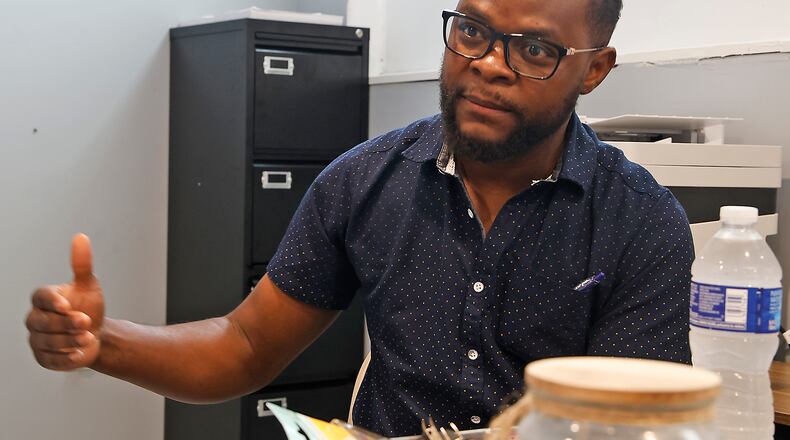Lindsay Aime, the community center’s treasurer and a board member, said many people are referring Haitian immigrants to the Haitian Community Help and Support Center to point them in the right direction or to provide direct assistance.
“We try to see if we can have enough to support any type of person [that] come and look for us, and we try to link up with different institutions to know what type of service they provide to see if we can not help them so we can refer to someone else,” Aime said.
Vilès Dorsainvil, the community center’s president, said the community needed a resource like this.
“To me the community could not wait for a structure like this, not only from the Springfield authorities but also from the Haitian nationals that we are all providing service for,” Dorsainvil said. “They felt like they find the place that they are looking for and also sort of the place that can serve as a bridge for them.”
Aime estimated the area has a population of about 15,000 Haitians, others estimate 10,000, though it is difficult to obtain exact numbers. He said additional English as a Second Language courses are another significant need for the Haitian population, and the center’s own weekly class sees around 100 participants.
Credit: Bill Lackey
Credit: Bill Lackey
Aime said as a Haitian immigrant who speaks English, he saw people coming to him for help.
“If people know you speak English, everybody come to you as a guide to help them to take care of some business, looking for a job, go to Walmart [to] buy something, go to the hospital if there is a need,” Aime said. “We see there’s a lot of needs for us.”
But the community center is not without its challenges.
Serving as a bridge
Dorsainvil said the location of the community center is not neutral, because it is the same building where a large congregation gathers each Sunday for church services. This gives some the impression the church operates the community center. Although the people who started it were connected through the church, this is not the case.
The community center is also understaffed to meet the increasingly large demand, Dorsainvil said. He said he, Joseph and Aime all have jobs outside of the help center, and they make time and rotate shifts to accommodate their schedules.
New services, like a food pantry, would be helpful for the community as well, but the community center does not have a good place to store food right now, Joseph said.
Staff also wants to build stronger relationships with the county and city to better serve as a “bridge” between local government and the Haitian community, Dorsainvil said.
“If we say that we are a community support center, we have to have the capacity and ability to provide the services that we say we are providing,” Dorsainvil said.
The rapidly increasing Haitian population has presented some challenges to the community, both the Haitian and non-Haitian.
Springfield Mayor Rob Rue, following a meeting with immigration officials and U.S. Rep. Mike Turner, R-Dayton on Capitol Hill, previously said areas that have felt the most strain with the increasing population include housing, local schools, employment, safe transportation and health care.
Clark County Commissioner Sasha Rittenhouse said after her own meetings on the Hill to discuss area needs with the growing population she feels there is an open line of communication with lawmakers that will hopefully lead to federal assistance in the forms of funding, grants and other help.
Rittenhouse, Rue and other local officials have said that bringing in such a large number of newcomers without an existing structure to provide organized support to the immigrants and soften the burden to local systems has created a challenging situation.
Asylum order
Katie Kersh, senior attorney with Advocates for Basic Legal Equality, said many Haitians coming here go to Mexico and get a CBP One, a mobile app that allows users to request appointments related to immigration, which allows them to be legally processed into the U.S. through what’s called the parole program. They then typically obtain Temporary Protected Status, which allows them to temporarily stay in the country. Others may apply for asylum, which is evaluated based on a person’s individual situation and if they were persecuted or have a fear of persecution, or for both TPS and asylum.
Federal action was taken early last week to address immigration challenges, but experts and Rep. Turner said this will not help the situation in Springfield.
“They’re not going to be implicated by this order because this order curbs the number of unlawful entries and so they’re all entering lawfully through CBP One, Kersh said.
Turner expressed disappointment in Biden’s executive order in a statement, calling it “too little, too late.”
“President Biden has spent the past three years neglecting the humanitarian crisis at the southern border, and his Executive Order is too little, too late. This action is nothing more than a political stunt and does nothing to address the misguided policies that have resulted in thousands of Haitian migrants being located to Springfield, Ohio,” Turner said.
What does the order do?
Biden issued the order after a bipartisan border security deal in Congress was blocked by Republicans.
The order bars migrants’ asylum applications from being processed while the number of border encounters between ports of entry is at an average of 2,500 per day, meaning it is now in effect. The restrictions will be in effect until two weeks after the daily encounter numbers are at or below 1,500 per day between ports of entry, under a seven-day average.
This means anyone who crosses the border without prior authorization will be ineligible for asylum unless they are an unaccompanied minor or an exception is made.
Haitians who come to the U.S. on parole typically are pre-approved to fly in then go through a screening process. Once in the U.S., they can pursue TPS and asylum.
TPS for Haitians is currently open, running through Aug. 3. Anyone on TPS will see their protected status end unless the re-registration period is extended again.
Credit: Bill Lackey
Credit: Bill Lackey
Similar parole processes exist for Cubans, Nicaraguans and Venezuelans.
According to the American Immigration Council, the Immigration and Nationality Act allows the secretary of Homeland Security to temporarily allow particular noncitizens to enter or stay in the country “if they are applying for admission but do not have a legal basis for being admitted.” DHS is allowed to grant parole if it determined there is an “urgent humanitarian or significant public benefit” reason for them to be in the country and their situation warrants discretion.
Parole is temporary and must be followed by another legal basis for staying in the U.S., like TPS or asylum.
Twenty Republican-led states, including Ohio, previously filed a lawsuit over the parole program, arguing it can only be applied on a “case-by-case basis for urgent humanitarian reasons or significant public benefit,” not by mass groups of people as it is currently being used. In March, a federal judge ruled the states did not have standing to bring the case.
About the Author



